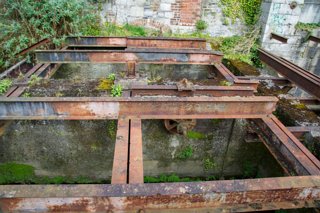CHAPELIZOD WEIR
I was a bit disappointed by what I saw.
Apparently the rusted metal and sluice gates that I saw are an important part of the weir but not the whole picture. The next time that I visit I know what else to look for:
The Main Structure:
The weir itself is a low, diagonal stone wall built across the River Liffey. It curves gently, and its primary purpose is to control water flow and create a more navigable section of the river.
The Full Sweep:
To fully appreciate the weir I need to try to find a vantage point (further upstream might be good) where I can see its entire length stretching across the river.
Upstream from the weir, the water is calmer, almost still, while just downstream there are small rapids and a more turbulent flow.
History of the Chapelizod Weir
The Chapelizod Weir has been a fixture on the Liffey for centuries! Here's a bit of its story:
Early Days:
It was likely constructed around 1800, making it over 200 years old. While the exact purpose of the original weir isn't entirely clear, historians suggest several possibilities:
- Navigation: Making the Liffey more navigable for trade vessels.
- Industry: Powering mills or other industries in the vibrant village of Chapelizod.
Remnants of the Past: Those rusted sluice gates and metal bits hint at the weir's industrial past and its original function of controlling water flow.
Why is the Weir Important?
- Landscape: The weir contributes significantly to the beauty and character of Chapelizod. The curve of the weir and the way it alters the river's flow create a visually appealing and unique feature.
- Historic Landmark: As a structure from the early 1800s, it's a testament to the village's industrial past and how communities interacted with the river.
- Ecosystem: Weirs can play a role in the river's ecology. They can create habitats and help with fish passage (there's a fish pass at the Chapelizod Weir).

CHAPELIZOD WEIR
SELECT AN IMAGE TO VIEW SLIDESHOWS